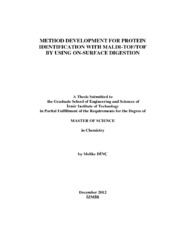Please use this identifier to cite or link to this item:
https://hdl.handle.net/11147/3549Full metadata record
| DC Field | Value | Language |
|---|---|---|
| dc.contributor.advisor | Yalçın, Talat | en |
| dc.contributor.author | Dinç, Melike | - |
| dc.date.accessioned | 2014-07-22T13:51:47Z | - |
| dc.date.available | 2014-07-22T13:51:47Z | - |
| dc.date.issued | 2012 | en |
| dc.identifier.uri | http://hdl.handle.net/11147/3549 | - |
| dc.description | Thesis (Master)--İzmir Institute of Technology, Chemistry, İzmir, 2012 | en |
| dc.description | Includes bibliographical references (leaves: 49-54) | en |
| dc.description | Text in English; Abstract: Turkish and English | en |
| dc.description | x, 58 leaves | en |
| dc.description.abstract | Protein identification is predominantly carried out by searching tandem mass spectrometric data of peptides in a protein database. For this reason, proteins are converted to peptides through a digestion process by using some certain endoproteinases. Trypsin is mostly preferred in this sample preparation step due to its high activity and products having appropriate mass range. Whereas in-solution digestion method is applied for the proteins in solution, proteins trapped in the gel can be digested by using in-gel digestion technique. Alternative to these traditional digestion methods, it has been reported that proteins can be digested too while they were adsorbed onto solid surfaces. In this study, digestion process of the adsorbed proteins, namely on-surface digestion is examined widely by using both hydrophobic and ionic adsorbents on different proteins. Results of the on-surface digestion were compared with in-solution digestion and in-gel digestion methods. As a conclusion, on-surface digestion is applicable for the protein identification by mass spectrometry; however, its yield may change from one experiment to another, depending on two separate but related processes: protein adsorption before the digestion and peptide recovery after the digestion. Nevertheless on-surface digestion has the advantages of protein enrichment and protein purification prior to mass spectrometry. These processes are necessary and significant especially for the samples containing minute amounts of protein and an effective enzymatic activity. Last but not least, this method may be performed complementarily to other digestion methods since new and different peptides may be acquired from the same sample source. | en |
| dc.language.iso | en | en_US |
| dc.publisher | Izmir Institute of Technology | en_US |
| dc.rights | info:eu-repo/semantics/openAccess | en_US |
| dc.subject.lcsh | Proteins--Analysis | en |
| dc.subject.lcsh | Mass spectrometry | en |
| dc.title | Method development for protein identification with MALDI-TOF/TOF by using on-surface digestion | en_US |
| dc.type | Master Thesis | en_US |
| dc.institutionauthor | Dinç, Melike | - |
| dc.department | Thesis (Master)--İzmir Institute of Technology, Chemistry | en_US |
| dc.relation.publicationcategory | Tez | en_US |
| item.languageiso639-1 | en | - |
| item.fulltext | With Fulltext | - |
| item.openairecristype | http://purl.org/coar/resource_type/c_18cf | - |
| item.openairetype | Master Thesis | - |
| item.grantfulltext | open | - |
| item.cerifentitytype | Publications | - |
| Appears in Collections: | Master Degree / Yüksek Lisans Tezleri | |
Files in This Item:
| File | Description | Size | Format | |
|---|---|---|---|---|
| T001080.pdf | MasterThesis | 3.8 MB | Adobe PDF |  View/Open |
CORE Recommender
Page view(s)
126
checked on Jul 22, 2024
Download(s)
88
checked on Jul 22, 2024
Google ScholarTM
Check
Items in GCRIS Repository are protected by copyright, with all rights reserved, unless otherwise indicated.